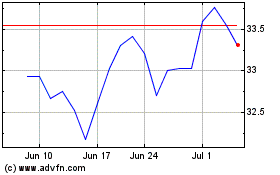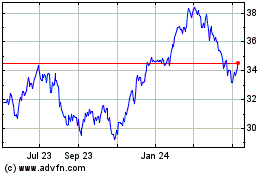North American Rail Traffic Fell 3.3% in Week Ended Aug. 31
September 04 2019 - 2:00PM
Dow Jones News
By Colin Kellaher
North American rail traffic fell 3.3% last week, as weakness in
the U.S. manufacturing sector continues to weigh on volumes, data
from the Association of American Railroads showed.
Carload volume and intermodal traffic for the week ended Aug. 31
on 12 reporting U.S., Canadian and Mexican railroads each fell
3.3%, the trade group said Wednesday.
North American rail traffic was 4.8% lower in the week ended
Aug. 24. For the first 35 weeks of the year, North American volume
is down 2.5%.
The AAR said U.S. rail traffic fell 4.5% last week after sliding
5.9% a week earlier. U.S. carloads fell 4.2% amid declines in eight
of the 10 commodity groups tracked, while the volume of U.S.
intermodal containers and trailers fell 4.9% for the week.
For the month of August, U.S. rail traffic fell 5%, marking the
seventh straight month of declines for both carloads and intermodal
units. U.S. rail traffic is now down 3.6% for the year to date, the
AAR said.
"While the strength of the overall economy remains unclear, in
the last quarter it has become much more evident that the portion
of the economy which generates freight--manufacturing and goods
trading--has weakened significantly," John Gray, AAR senior vice
president, said of the U.S. data.
"We had a similar pattern in 2016, when rail traffic was weak
and the overall economy wobbled but didn't fall down," Mr. Gray
added. "Railroads are hopeful that the uncertainty plaguing
economies here and abroad will dissipate soon and solid economic
and industrial growth will return."
Union Pacific Corp. (UNP) earlier Wednesday said it now expects
its freight volumes in the second half of the year will fall in the
mid-single digits, compared with a July forecast for a decline of
about 2%.
Adding to the pain, Moody's Investors Service on Wednesday said
it expects coal demand from utilities will drop by more than 50% by
2030, weighing on U.S. railroads. Coal is the largest freight
commodity, excluding intermodal units.
"Our forecast of a more than 50% drop in coal demand from
utilities by 2030 implies that coal demand would decline by about
7% per annum on average over the next 10 years, which would
translate into roughly $5 billion in lost revenues for the
railroads, or 5.5% of 2018 industry revenues," Moody's said.
Elsewhere in North America, the AAR said rail traffic edged up
0.3% in Canada last week, as a 2.2% rise in intermodal units more
than offset a 1.3% drop in carloads.
Rail traffic slipped 0.4% in Mexico last week, the AAR said,
with intermodal units and carloads both down 0.4%.
Write to Colin Kellaher at colin.kellaher@wsj.com
(END) Dow Jones Newswires
September 04, 2019 13:45 ET (17:45 GMT)
Copyright (c) 2019 Dow Jones & Company, Inc.
CSX (NASDAQ:CSX)
Historical Stock Chart
From Mar 2024 to Apr 2024

CSX (NASDAQ:CSX)
Historical Stock Chart
From Apr 2023 to Apr 2024
